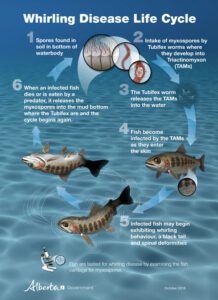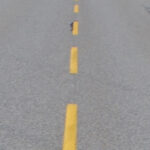Home »

What’s the deal with Whirling Disease?
By East Kootenay Invasive Species Council
Recent findings in October 2023 revealed the presence of Whirling Disease in British Columbia for the first time in Yoho and Kootenay National Parks. This invasive and parasitic condition, caused by Myxobolus cerebralis, has raised concerns as it affects various salmonid species, including whitefish, trout, and salmon.
The disease, with origins in Europe, has been spreading across Southern Alberta, including Bow, Old Man, Spray, Red Deer, North Saskatchewan, and Crowsnest Rivers. Additionally, it has made its way into neighbouring U.S. states like Montana, Idaho, and Washington and is now present in British Columbia.
Identifying infected fish is crucial. They often exhibit abnormal swimming patterns, darkened tails, deformed heads, and bulging eyes due to cartilage damage in their backbones. Juvenile fish are particularly vulnerable to the disease.
 Understanding the life cycle of M. cerebralis is essential for combating its spread. The parasite alternates between a worm host, Tubifex tubifex, and a salmonid fish. Myxospores released by infected fish are consumed by the worm, which then produces triactinomyxon spores (TAMs) that infect fish
Understanding the life cycle of M. cerebralis is essential for combating its spread. The parasite alternates between a worm host, Tubifex tubifex, and a salmonid fish. Myxospores released by infected fish are consumed by the worm, which then produces triactinomyxon spores (TAMs) that infect fish
The introduction of Whirling Disease to Canada, first detected in 2016, poses significant challenges. It is unclear whether transmission occurred via wildlife or contaminated angling gear. The disease’s longevity in sediment-covered beds underscores the importance of preventative measures, such as cleaning wading boots and equipment.
The impacts of Whirling Disease extend beyond fish populations. It disrupts ecosystems, leading to imbalances in fish age groups and trophic cascades. While the parasite does not directly affect humans, it impacts recreational activities and commercial fisheries.
Unfortunately, there is no known cure for Whirling Disease, making prevention paramount.
 Best Practices for preventing the spread of Whirling Disease:
Best Practices for preventing the spread of Whirling Disease:
- Never move fish or fish parts from one waterbody to another.
- Use fish cleaning stations where available or put fish parts in the local solid waste system. Do not dispose of fish or any fish parts in a kitchen garburator.
- Clean, Drain, and Dry boats or any equipment (waders, life jackets, kayaks, etc.) before moving between waterbodies:
Clean
– Clean and inspect watercraft, trailers, and all equipment that has been in contact with water or fish. This includes boats, motors, bait buckets, and swim floats.
– Remove all mud, sand, and plant material before leaving the shore.
– Rinse, scrub, or pressure wash your boat away from storm drains, ditches, or waterways.
– Bathe pets before allowing them to enter another water body.
Drain
– Before leaving the shoreline, drain water from watercraft and equipment onto dry land.
Dry
– Dry the watercraft and/or equipment completely between trips and allow the wet areas to air dry. Allow a minimum of 24 hours of drying time before entering new waters.
– Leave compartments open on boats and equipment and sponge out standing water.
Implementing practices like the “Clean Drain Dry” method and adhering to inspection protocols when traveling into British Columbia can mitigate its spread. Additionally, reporting sightings of invasive species is crucial for effective management. Let’s remain vigilant in safeguarding our waterways and ecosystems from the threat of Whirling Disease.
East Kootenay Invasive Species Council Images







